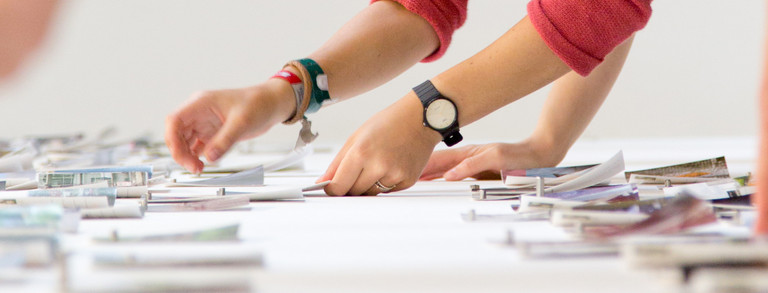Drawing, printmaking & graphic design
Notes on teaching
‘Good teaching in graphic art is characterised by a high level of openness towards a diversity of artistic approaches, and the level of intensity achieved in the drawings and prints. After decades of teaching in schools and universities, and from my own experience as an artist, it has become clear to me that an examination of public and private spaces should be central. These spaces become occasions for drawing by arousing curiosity, and providing impulses for artistic development. It is important to engage with what is visible, to clarify one's own motivation, to develop guiding ideas, and to make decisions regarding materials. The social, architectural, scenic, or biographical realities are registered and become projection surfaces for one's own state of mind. Inner images emerge that would not be conceivable without the visual challenges presented. Drawing artists transform the world of things through impressions and the will to express; thus, reflecting physical sensations, conditions, and ideas. Many work directly on site—whether with graphite, fineliners, charcoal, watercolour, or acrylic paint—while others require spatial and temporal distance to react to what they observe, achieving new artistic findings through photographs they have taken themselves. Collage, digital processing, intaglio printing or relief printing expand these approaches. Manipulating realistic perspective is only feasible from a foundational understanding of spatial construction; for instance: the increasing low- and high-angle views. Rules governing the depiction of space are best understood by verbalising the situation while checking the axes of spatial relations.
It is not predominantly about documentation or direct reproduction of what is actually visible; rather, the desire to condense, reorganise, deform and play is much stronger. In this manner, recognised objects become part of their own chains of association and are transformed into subjective narratives. The aim is to invent through authentic experience and perception. It is not uncommon for drawn wit to manifest itself because of the tension between expectation and resolution. Throughout this process, one must break traditional patterns of thinking and take risks; thus, achieving a social impact.
In printmaking specifically, there exists a heightened desire for materiality and experimentation. Knowledge of technique and craft remains fundamental but should not be regarded as an end in itself. Elementary procedures associated with individual printmaking techniques are adequately described in specialised literature; however—the decisive factor within the artistic process lies in individual modification alongside further development of one’s own artistic findings. If pursued consistently, classical rules can be playfully subverted. New paths are particularly explored within hybrid techniques along with innovative forms of presentation—for example: combinations involving embroidery alongside etching; borderless etchings suspended within wall installations; integrations between etching alongside computer printing as well as drawings; employing controlled processes using solvents in relief or stamp printing across various materials. Experimentation with different types of paper or textiles as mediums—water-soluble versus oil-soluble colours—and varying sizes is exciting. A life-size format often presents a compelling challenge that facilitates exploration into densities and empty spaces while confronting viewers with dimensions matching their own mirror image.
This exploration of printmaking does not strive simply towards reproducing drawings or paintings—or photographs (for otherwise it would indeed constitute pure anachronism today); instead—it seeks to achieve artistic findings originally stemming from both material conditions and the printing process itself. New is digital printmaking, which allows different, sincere experiments by means of drawn composition— for example using a drawing tablet, the stamp effect, enlargements or reductions, colour transformations, overlapping, stretching, tilting without spatial stability or erasure.
Teaching graphic art is about the range between expressive-processual actions and conceptual practices alike. Both, classical methodologies as well extensions across media, can yield valid findings. Numerous drawing artists work from direct observation and examine the moving environment, which appeals to all the senses. Changes in location and proportion are thus possible. Aims may be diverging degrees of abstraction, changes of viewpoint and strokes. Pictorial narratives frequently draw upon combinations of direct experience, photographic artefacts and memory.
Drawing projects that abandon the mere illusion of spatial depth on a flat surface and extend into the room are particularly exciting, whether through hanging or evolving cut-out figures or incorporating immaterial forms of light and shadow. With conceptual projects, extracted elements are transcribed into new systems.
Thus, the central aspects of graphic art are energetic traces, rhythm, tension, courage and an exploratory attitude.’
Bettina van Haaren, 2017




